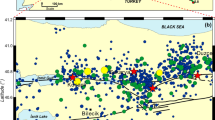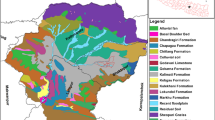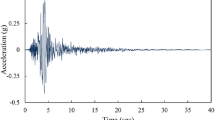Abstract
Nested Newmark model (NNM) can obtain the post-earthquake profile of the slopes in limit equilibrium or limit analysis method. The purpose of this study is to extend the NNM from the limit equilibrium method to a limit analysis method, and then involve the dynamic response of slopes into the prediction of the permanent displacement based on decoupled analysis. Parametric studies are carried out to further investigate the influences of slope height, soil shear wave velocity and input ground motion. The calculated results indicate that neglecting the dynamic response of slopes can underestimate the post-earthquake displacements. As the slope height increases or shear wave velocity reduces, the underestimation is more significant. At the fundamental natural period of the site, the underestimation is particularly remarkable. For induced earthquake waves with a small value of mean period, the influence of the dynamic response can be ignored when the fundamental period deviates from the mean period.
Similar content being viewed by others
Reference
Aminpour MM, Maleki M and Ghanbari A (2018), “Predicting Seismic Permanent Displacement of Soil Walls Under Surcharge Based on Limit Analysis Approach,” Earthquake Engineering and Engineering Vibration, 17(4): 747–759.
Baker R and Garber M (1978), “Theoretical Analysis of the Stability of Slopes,” Géotechnique, 28(4): 395–411.
Bouckovalas GD and Papadimitriou AG (2005), “Numerical Evaluation of Slope Topography Effects on Seismic Ground Motion,” Soil Dynamics and Earthquake Engineering, 25(7–10): 547–558.
Chugh AK and Stark TD (2006), “Permanent Seismic Deformation Analysis of a Landslide,” Landslides, 3(1): 2–12.
Dai D, Zhang N, Lee VW, Gao Y and Chen X (2019), “Scattering and Amplification of SV Waves by a Semi-Cylindrical Hill in a Half-Space by a Wavefunction-Based Meshless Method Using Mapping and Point-Matching Strategies,” Engineering Analysis With Boundary Elements, 106: 252–263.
Goodman PE and Seed HB (1966), “Earthquake-Induced displacements in Sand Embankments,” Journal of Soil Mechanics & Foundations Div, 92(2): 125–146.
Hashash YMA, Musgrove MI, Harmon JA, Groholski DR, Phillips CA and Park D (2016), DEEPSOIL 6.1, User Manual, Urbana, IL, Board of Trustees of University of Illinois at Urbana-Champaign.
Hong Y-S, Chen R-H, Wu C-S and Chen J-R (2005), “Shaking Table Tests and Stability Analysis of Steep Nailed Slopes,” Canadian Geotechnical Journal, 42(5): 1264–1279.
Huang CC, Wu SH and Wu HJ (2009), “Seismic Displacement Criterion for Soil Retaining Walls Based on Soil Strength Mobilization,” Journal of Geotechnical and Geoenvironmental Engineering, 135(1): 74–83.
Jibson RW (2011), “Methods for Assessing the Stability of Slopes During Earthquakes—A retrospective,” Engineering Geology, 122(1–2): 43–50.
Kutter B and James R (1989), “Dynamic Centrifuge Model Tests on Clay Embankments,” Géotechnique, 39(1): 91–106.
Lee KL (1974). Seismic Permanent Deformations in Earth Dams, Report No. UCLA-ENG-7497, School of Engineering and Applied Science, University of California at Los Angeles.
Leshchinsky BA (2018), “Nested Newmark Model to Ealculate the Post-Earthquake Profile of Slopes,” Engineering Geology, 233: 139–145.
Leshchinsky D, Baker R and Silver ML (1985), “Three Dimensional Analysis of Slope Stability,” International Journal for Numerical and Analytical Methods in Geomechanics, 9(3): 199–223.
Lin M-L and Wang K-L (2006), “Seismic Slope Behavior in a Large-Scale Shaking Table Model Test,” Engineering Geology, 86(2–3): 118–133.
Ling HI and Leshchinsky D (1995), “Seismic Performance of Simple Slopes,” Soils and Foundations, 35(2): 85–94.
Makdisi FI and Seed HB (1978), “Simplified Procedure for Estimating Dam and Embankment Earthquake-Induced Deformations,” Journal of Geotechnical and Geoenvironmental Engineering, 104.
Newmark NM (1965), “Effects of Earthquakes on Dams and Embankments,” Géotechnique, 15(2): 139–160.
Rathje EM and Bray JD (2001), “One-and Two-Dimensional Seismic Analysis of Solid-Waste Landfills,” Canadian Geotechnical Journal, 38(4): 850–862.
Sarma SK and Bhave MV (1974), “Critical Acceleration Versus Static Factor of Safety in Stability Analysis of Earth Dams and Embankments,” Géotechnique, 24(4): 661–665.
Sarma SK (1975), “Seismic stability of earth dams and embankments,” Géotechnique, 25(4): 743–761.
Seed HB, Idriss IM, Lee KL and Makdisi FI (1975), “Dynamic Analysis of the Slide in the Lower San Fernando Dam during the Earthquake of February 9, 1971,” Journal of Geotechnical and Geoenvironmental Engineering, 101(9): 889–911.
Serff N, Seed HB, Makdisi FI and Chang CY (1976), Earthquake-Induced Deformations of Earth Dams, Report EERC 76–4. Earthquake Engineering Research Center, University of California, Berkeley.
Terzaghi K (1950), Mechanisms of landslides. Engineering Geology (Berkey) Volume, Geological Society of America.
Wartman J, Seed RB and Bray JD (2005), “Shaking Table Modeling of Seismically Induced Deformations in Slopes,” Journal of Geotechnical and Geoenvironmental Engineering, 131(5): 610–622.
Yang S, Leshchinsky B, Cui K, Zhang F and Gao Y “Influence of Failure Mechanism on Seismic Bearing Capacity Factors for Shallow Foundations Near Slopes,” Géotechnique, 0 (0): 1–14. https://doi.org/10.1680/jgeot.19.P.329
You L and Michalowski RL (1999), “Displacement Charts for Slopes Subjected to Seismic Loads,” Computers and Geotechnics, 25(1): 45–55.
Zhang Ning, Gao Yufeng, Wu Yongxin and Zhang Fei (2018), “A Note on Near-Field Site Amplification Effects of Ground Motion from a Radially Inhomogeneous Valley,” Earthquake Engineering and Engineering Vibration, 17(4): 707–718. https://doi.org/10.1007/s11803-018-0470-9.
Author information
Authors and Affiliations
Corresponding author
Additional information
Acknolegement
Financial support by the National Natural Science Foundation of China (Grant Nos. 41630638 and 41602280), the National Key Research and Development Program of China (Grant No. 2016YFC0800205), the Program of Introducing Talents of Discipline to Universities (111 Project; Grant No. B13024) is gratefully acknoledged.
Supported by
National Natural Science Foundation of China under Grant Nos. 41630638 and 41602280, the National Key Research and Development Program of China under Grant No. 2016YFC0800205, the Program of Introducing Talents of Discipline to Universities 111 Project under Grant No. B13024
Rights and permissions
About this article
Cite this article
Zheng, Z., Yufeng, G., Fei, Z. et al. Effects of soil dynamic response on post-earthquake deformation of slopes based on nested Newmark model. Earthq. Eng. Eng. Vib. 19, 573–582 (2020). https://doi.org/10.1007/s11803-020-0581-y
Received:
Accepted:
Published:
Issue Date:
DOI: https://doi.org/10.1007/s11803-020-0581-y




